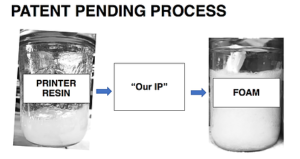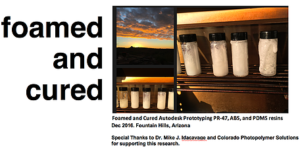 In addition to gathering together the latest technologies and materials, 3D printing industry events offer invaluable networking opportunities; the people often make the event, and that goes just as much for fellow attendees as it does for keynotes and scheduled speakers. It was at RAPID + TCT 2017 that I met MIT research specialist Matthew Pearlson, who attended the event to learn more about 3D printing. Learn he certainly has, and it was a pleasure to hear from him recently regarding a new innovation he’s ready to share with the world.
In addition to gathering together the latest technologies and materials, 3D printing industry events offer invaluable networking opportunities; the people often make the event, and that goes just as much for fellow attendees as it does for keynotes and scheduled speakers. It was at RAPID + TCT 2017 that I met MIT research specialist Matthew Pearlson, who attended the event to learn more about 3D printing. Learn he certainly has, and it was a pleasure to hear from him recently regarding a new innovation he’s ready to share with the world.
Pearlson is also the founder of The Foam Printing Project, an innovative advance building on his idea to use additive manufacturing and lightweight foam for the creation of lighter-weight structures so the world could use less fuel. As we spoke recently, he highlighted his background in chemical engineering, fuel, R&D, aviation, and environmental awareness as providing a strong foundation to build upon to do the unexpected: make a difference within his own lifetime. In part one of our interview, we examine Pearlson’s idea for a new technology; in part two, we look at potential implications and applications for a lighter-weight future.
“I thought we wouldn’t make a difference in fuels in my lifetime, in my children’s lifetimes. So I thought, the best we can do is to lightweight. That’s where 3D printing comes in, and I went to RAPID to learn about 3D printing; I didn’t know anything about it,” he told me. “I’ve been working away independently in the research lab. I developed the technology and patented it, and now I’m looking forward to sharing with the world.”
Foam has long been popular as a lightweight material with unique physical properties, and has been gaining traction within the 3D printing space as research and development efforts increasingly focus on viable foam solutions. Pearlson’s efforts coincide well with this rising interest, and his research offers a unique value proposition focused on stereolithography (SLA) 3D printing.
“Keep the resins, keep the machines, keep the process everyone knows and has been using the last 30 years — but print more for the same amount of money, or reduce cost by three-quarters because 75% of the part can be gas,” he explained.
“You can use material, but everything else is the same: post-processing, engineering, design. There’s a slight retrofit to get the foam into the printer. I think, I hope, that some of the larger SLA companies will say this is something novel, neat — say, ‘This is something we can use to add value to the enterprise, we want to license it.’ The value proposition is that it all stays the same, except this tweak to the system. Tweak the recoater blade, then it’s off to the races printing foam. You get the same excellent surface finish, and can use things like topology optimization to lightweight parts.”
SLA is a well-known 3D printing technology, and adapting to foam allows for a broad potential use base.
This innovative new approach didn’t begin initially with foam, though, as Pearlson explained that his original plan had been to marry SLA and carbon fiber. This experiment, tried with a friend, didn’t go well. In fact, he told me, the material “turned into brownie batter — it’s no longer liquid, it becomes very viscous and doesn’t flow well.” While work is continuing as well with 3D printable viscous materials, Pearlson chose another route, thinking on weaving the fibers. Here he had the thought that “foaming it could be interesting, to use heat or some mechanism to align fibers in the same way.”“I wanted to start simple, without the fibers, and focus on the foam,” he said. “I’ve been focusing exclusively on the foam aspect. Development is going very well. I have a $25,000 no-strings grant from MIT to pursue the research; they gave me space in a prototyping shop, and I got a top-down desktop SLA machine and basically hacked it. I wrote some custom code to move the servos up and down for control.”
Working with the DLP system, Pearlson hacked and tweaked the equipment, adjusting for a reaction vessel to dispense the foam, and coming up with his proof of concept. The proof was in the pudding — or, rather, the foam — as he explained that now he is able to create dimensionally accurate parts that come out lighter.
“Development has been a lot of fun,” he enthused.
Pearlson’s cross-disciplinary background and fields of knowledge have converged in this project, bringing his experience as a chemical engineer with significant lab time together with work in business development, project development, and wind and solar power projects. Back in the lab for about the last two years, he expresses enthusiasm about this project, noting that, “It’s been fun putting my lab coat on again, rolling up my sleeves, and making things work.”
Having discussed background and the process, I asked Pearlson about the implications for his work: what is the great hope for foam 3D printing?
We discussed near-term and far-future potential applications for the Foam Printing Project, beginning with drones and aerospace and potentially expanding to rethinking full city infrastructure, with Pearlson’s vision shared in part two of this in-depth intervew.
Discuss foam and other 3D printing topics at 3DPrintBoard.com, or share your thoughts in the Facebook comments below.
[All images: Matthew Pearlson/The Foam Printing Project]
Subscribe to Our Email Newsletter
Stay up-to-date on all the latest news from the 3D printing industry and receive information and offers from third party vendors.
Print Services
Upload your 3D Models and get them printed quickly and efficiently.
You May Also Like
Nikon SLM Solutions Sells SLM 500 to Primary Weapon Systems to Expand Suppressor Production
Primary Weapons Systems (PWS) is a Boise, Idaho-based manufacturer of suppressors, firearms, and related components. A subsidiary of Vigilant Gear and a sister company to aftermarket Glock slide manufacturer Lone...
3DPOD 261: Tooling and Cooling for AM with Jason Murphy, NXC MFG
Jason Murphy´s NXC MFG (Next Chapter Manufacturing) is not a generalist service; instead, the company specializes in making tooling. Using LPBF and binder jet, the company produces some of the...
HP and Firestorm Labs Form Partnership to Use Multi Jet Fusion 3D Printers in Deployable Factories
HP Inc., maker of a range of additive manufacturing (AM) solutions including the Multi Jet Fusion (MJF) ecosystem, has announced a partnership with Firestorm Labs, a developer of containerized, deployable...
3D Printing News Briefs, July 2, 2025: Copper Alloys, Defense Manufacturing, & More
We’re starting off with metals in today’s 3D Printing News Briefs, as Farsoon has unveiled a large-scale AM solution for copper alloys, and Meltio used its wire-laser metal solution to...





































